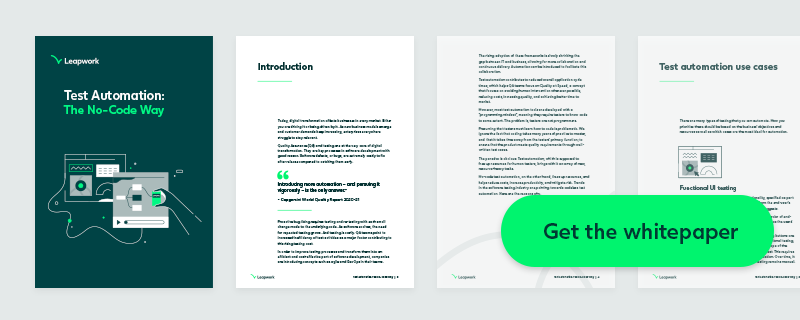GxP Validation: Overview and Best Practice Guide
GxP is the gold standard in regulatory compliance. Companies in highly regulated industries quite simply can’t operate without GxP compliance, so it’s of the utmost importance to achieve set standards and show evidence of this. This is where GxP validation comes in.
Luckily, technology is making it much easier to validate things. This article gives an overview of GxP's role in highly regulated industries and explores how technology such as automation can help accelerate GxP validation.
Skip ahead to:
What is GxP?What does GxP stand for?
What is GxP validation?
GxP Systems Validation Process
GxP Validation Testing
GxP Validation with Test Automation
What is GxP?
GxP represents a broad category of regulations and guidelines aimed at ensuring that products are safe, effective, and of high quality. These rules apply to how products are made, controlled, stored, and shipped.
GxP is all about consistency. GxP guidelines ensure that products are always produced and controlled according to quality standards, safeguarding consumer safety and efficacy.
Adherence to GxP regulations is not just a regulatory requirement; it's about making sure your products are trustworthy and reliable every step of the way.
What does GxP stand for?
When we say "GxP," think "Good Practice." The "G" stands for "Good" and the "P" for "Practice," with the "x" serving as a placeholder for the specific field, such as Manufacturing (GMP), Laboratory (GLP), Clinical (GCP), etc.
Good Practice (GxP) standards are set by governing agencies like the Food and Drug Administration (FDA) in the US. GxP serves as a quality benchmark in sectors where safety and efficacy are paramount, placing a considerable responsibility on manufacturers to comply with these standards rigorously.
For manufacturers, it's a big effort to meet these standards, but it's all for a good reason - to keep us safe and healthy.
What is GxP validation?
GxP validation means proving that you're doing things the right way. It is a documented process that demonstrates a system or process operates within the predefined parameters for a specific intended use.
In industries subject to GxP regulations, this validation process is essential. It not only ensures compliance with legal and quality standards but also helps in maintaining the integrity of data, ensuring the safety of products, and protecting consumer health.
GxP Systems Validation Process
The GxP Systems Validation Process involves several key steps to ensure that systems comply with the required standards. This process typically includes:
- Planning: Defining what needs to be validated and establishing the scope.
- Specification: Detailing the requirements and setting the standards for outcomes.
- Design Qualification (DQ): Documenting the system design and ensuring it meets the necessary specifications.
- Installation Qualification (IQ): Verifying the installation according to the manufacturer's specifications.
- Operational Qualification (OQ): Demonstrating the system operates according to the intended purpose under specified conditions.
- Performance Qualification (PQ): Proving the system performs effectively and consistently during normal operation.
- Revalidation: Ensuring the system remains in a state of compliance over time.
GxP Validation Testing
Testing plays a huge role in achieving and ensuring GxP-compliance through ongoing validation.
However, it can be difficult for many companies to test to a satisfactory degree due to time and resource constraints. Manual testing methods can be labor-intensive and error-prone, making it difficult to meet the strict requirements of GxP validation.
More and more companies within highly regulated industries are turning to test automation to get the level of coverage and accuracy they need from testing. By automating repetitive and time-consuming tasks, you can use your resources more effectively. Essentially, it makes your testing much faster and more reliable.
Related reading: What is the Difference Between Manual Testing and Automation Testing?
GxP Validation with Test Automation
Test automation improves the GxP validation process by making tests repeatable, consistent, and well-documented. It allows for continuous testing, providing immediate feedback for swift adjustments.
This ongoing testing is vital for staying compliant in industries that move quickly and are subject to frequent changes. Additionally, the scalability of automated testing means that as regulations change, testing protocols can be easily updated to meet new requirements without major revisions or delays.
Some test automation tools feature built-in video screen recording, documenting test cases and outcomes. This is particularly valuable in regulated sectors where audit trails or verification are necessary and must be readily available.
According to Pharma IT, a healthcare consultancy firm, test automation tools and frameworks in GxP environments can speed up the validation process, reduce the risk of human error, and lower costs associated with manual testing.
It’s worth noting that more complex automation frameworks like Selenium tend to require a large amount of technical resources to manage. You can overcome these barriers with codeless test automation.
Related reading: Top 5 Selenium Alternatives
GxP Validation with Test Automation Example
NecstGen is an example of a company leveraging test automation for GxP validation.
As a healthcare organization focused on the clinical advancement of cell and gene therapies, Necstgen needed to prove its systems and processes were safe and compliant with GMP requirements.
The use of a Laboratory Information Management System (LIMS) built on Salesforce needed rigorous testing.
The integration of Leapwork's test automation platform facilitated a transformative shift in Necstgen's approach to GxP validation, showing the impact of test automation in regulated industries.
Here’s what they achieved:
- 100% test coverage with a fully automated test suite.
- Efficient and cost-effective operations compliance.
- Permanently accessible documentation for witnessing through video logs.
- Used testing insights to make their product development even better.

